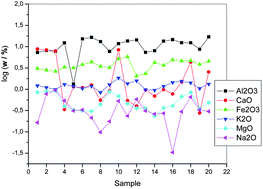Determination of chemical composition of pottery from antic Siscia by ICP-AES after enhanced pressure microwave digestion
Abstract
This study describes the results of chemical characterization of archaeological pottery excavated at Sisak, Croatia known as prehistoric town Segestica (IV–I century BC) or Siscia, the capital of Roman province Pannonia Savia (I–IV century AD). Chemical composition of pottery shards and a sample of raw clay material was determined by


 Please wait while we load your content...
Please wait while we load your content...